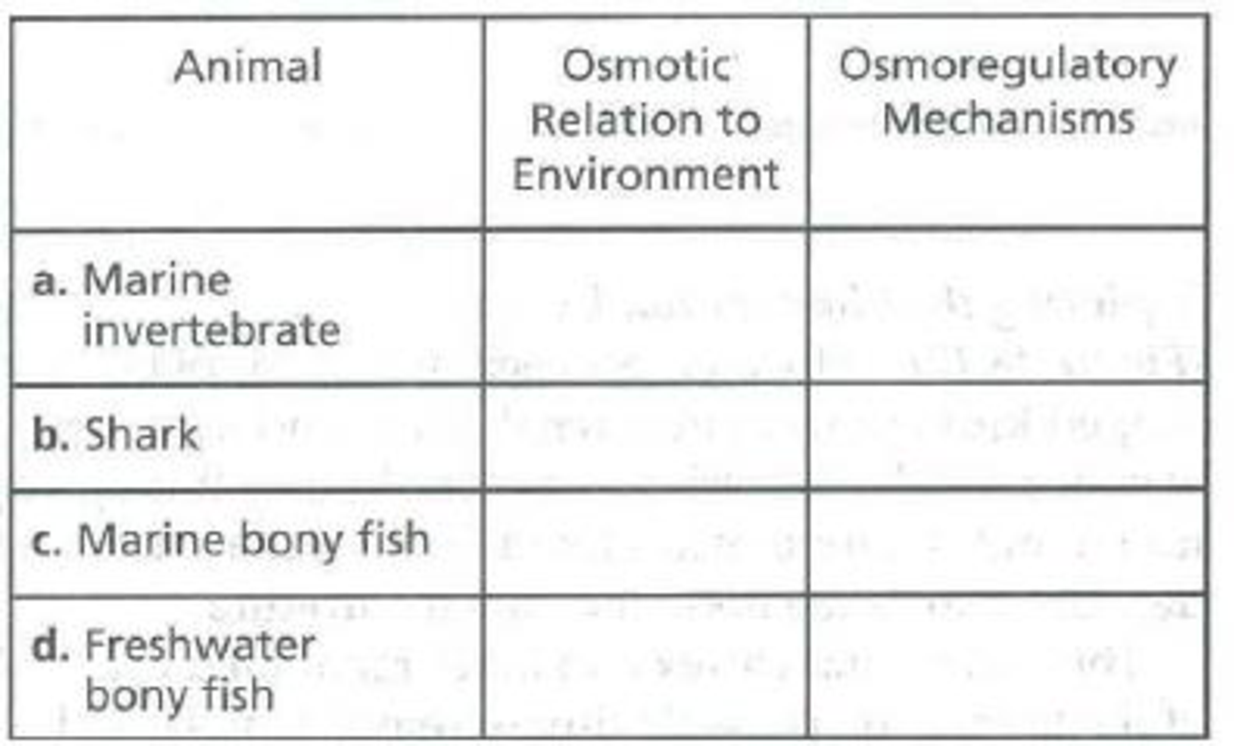
Indicate whether the following animals are isoosmotic, hyperosmotic, or hypoosmotic to their environment and identify their osmoregulatory mechanisms.

To determine: Whether the following animals are isosmotic, hyperosmotic, or hypoosmotic to their environment and to identify their osmoregulatory mechanisms.
Introduction: The maintenance of osmotic pressure within the body is known as osmoregulation. Changes in osmotic pressure are usually sensed by the osmoreceptors that influence the downstream signaling pathways to maintain the homeostasis. Based on its osmotic regulation process the organism is classified into two types namely osmoregulators and osmoconformers. Osmoregulators concentrates and maintains the internal osmotic pressure whereas the osmoconformers involve in the matching of its body osmotic pressure to the environmental osmotic pressure.
Explanation of Solution
| Animal | Osmotic relation to environment | Osmoregulatory mechanism |
| a. Marine invertebrate. | Isosmotic: This organism has an internal environment with the same osmotic pressure that is found in the external environment. | Marine invertebrate is the osmoconformers. Though they have the same osmotic pressure to that of environment this organism regulates the specific solutes for its biological functions. Examples are starfish, mussels, lobsters, and jellyfish. |
| b. Shark. | Slightly hyperosmotic: The shark has slightly higher osmotic pressure than that of its external environment. It has more salinity in the body than in the ocean. | Shark regulates the osmotic pressure by maintaining high amounts of urea and trimethylamine oxide (TMAO) in the body. The excess salts are excreted through kidney and in feces. |
| c. Marine bony fish | Hypoosmotic: The marine bony fish has less osmotic pressure when compared to its external environment. | This organism has the tendency to lose water through gills since it is hypoosmotic to the environment. However, it is compensated by drinking of seawater to maintain the osmotic pressure. Excess salt in the body is excreted through gills. This organism excretes less amount of urine. |
| d. Freshwater bony fish. | Hyperosmotic: The freshwater bony fish has higher osmotic pressure in its internal environment when compared to its external environment. | Due to the hypoosmotic condition in the external environment, there is more loss of salt from the body. Thus it maintains the osmotic pressure by preventing the loss of salt and intake of water. Therefore it produces more amount of dilute urine and it intakes the salt through gills. |
Want to see more full solutions like this?
Chapter 44 Solutions
Study Guide for Campbell Biology
- What is this?arrow_forwardMolecular Biology A-C components of the question are corresponding to attached image labeled 1. D component of the question is corresponding to attached image labeled 2. For a eukaryotic mRNA, the sequences is as follows where AUGrepresents the start codon, the yellow is the Kozak sequence and (XXX) just represents any codonfor an amino acid (no stop codons here). G-cap and polyA tail are not shown A. How long is the peptide produced?B. What is the function (a sentence) of the UAA highlighted in blue?C. If the sequence highlighted in blue were changed from UAA to UAG, how would that affecttranslation? D. (1) The sequence highlighted in yellow above is moved to a new position indicated below. Howwould that affect translation? (2) How long would be the protein produced from this new mRNA? Thank youarrow_forwardMolecular Biology Question Explain why the cell doesn’t need 61 tRNAs (one for each codon). Please help. Thank youarrow_forward
- Molecular Biology You discover a disease causing mutation (indicated by the arrow) that alters splicing of its mRNA. This mutation (a base substitution in the splicing sequence) eliminates a 3’ splice site resulting in the inclusion of the second intron (I2) in the final mRNA. We are going to pretend that this intron is short having only 15 nucleotides (most introns are much longer so this is just to make things simple) with the following sequence shown below in bold. The ( ) indicate the reading frames in the exons; the included intron 2 sequences are in bold. A. Would you expected this change to be harmful? ExplainB. If you were to do gene therapy to fix this problem, briefly explain what type of gene therapy youwould use to correct this. Please help. Thank youarrow_forwardMolecular Biology Question Please help. Thank you Explain what is meant by the term “defective virus.” Explain how a defective virus is able to replicate.arrow_forwardMolecular Biology Explain why changing the codon GGG to GGA should not be harmful. Please help . Thank youarrow_forward
- Stage Percent Time in Hours Interphase .60 14.4 Prophase .20 4.8 Metaphase .10 2.4 Anaphase .06 1.44 Telophase .03 .72 Cytukinesis .01 .24 Can you summarize the results in the chart and explain which phases are faster and why the slower ones are slow?arrow_forwardCan you circle a cell in the different stages of mitosis? 1.prophase 2.metaphase 3.anaphase 4.telophase 5.cytokinesisarrow_forwardWhich microbe does not live part of its lifecycle outside humans? A. Toxoplasma gondii B. Cytomegalovirus C. Francisella tularensis D. Plasmodium falciparum explain your answer thoroughly.arrow_forward
- Select all of the following that the ablation (knockout) or ectopoic expression (gain of function) of Hox can contribute to. Another set of wings in the fruit fly, duplication of fingernails, ectopic ears in mice, excess feathers in duck/quail chimeras, and homeosis of segment 2 to jaw in Hox2a mutantsarrow_forwardSelect all of the following that changes in the MC1R gene can lead to: Changes in spots/stripes in lizards, changes in coat coloration in mice, ectopic ear formation in Siberian hamsters, and red hair in humansarrow_forwardPleiotropic genes are genes that (blank) Cause a swapping of organs/structures, are the result of duplicated sets of chromosomes, never produce protein products, and have more than one purpose/functionarrow_forward
 Human Physiology: From Cells to Systems (MindTap ...BiologyISBN:9781285866932Author:Lauralee SherwoodPublisher:Cengage Learning
Human Physiology: From Cells to Systems (MindTap ...BiologyISBN:9781285866932Author:Lauralee SherwoodPublisher:Cengage Learning Human Biology (MindTap Course List)BiologyISBN:9781305112100Author:Cecie Starr, Beverly McMillanPublisher:Cengage Learning
Human Biology (MindTap Course List)BiologyISBN:9781305112100Author:Cecie Starr, Beverly McMillanPublisher:Cengage Learning Concepts of BiologyBiologyISBN:9781938168116Author:Samantha Fowler, Rebecca Roush, James WisePublisher:OpenStax College
Concepts of BiologyBiologyISBN:9781938168116Author:Samantha Fowler, Rebecca Roush, James WisePublisher:OpenStax College Biology (MindTap Course List)BiologyISBN:9781337392938Author:Eldra Solomon, Charles Martin, Diana W. Martin, Linda R. BergPublisher:Cengage Learning
Biology (MindTap Course List)BiologyISBN:9781337392938Author:Eldra Solomon, Charles Martin, Diana W. Martin, Linda R. BergPublisher:Cengage Learning Biology: The Dynamic Science (MindTap Course List)BiologyISBN:9781305389892Author:Peter J. Russell, Paul E. Hertz, Beverly McMillanPublisher:Cengage Learning
Biology: The Dynamic Science (MindTap Course List)BiologyISBN:9781305389892Author:Peter J. Russell, Paul E. Hertz, Beverly McMillanPublisher:Cengage Learning





